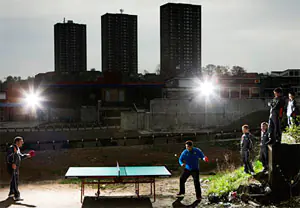Who among us as a child did not play table tennis at home on an ordinary folding table-book? What about football or handball with trees instead of bars and an imaginary non-existent crossbar? Of course, at that time we had enough of this. However, in this article we will continue the story about simple sports designsavailable for production with your own hands. What else can be done for our improvised, homemade yard sports ground?
Content- Handball goal
- DIY tennis table
- Throwing wall
- Ball practice wall
Handball goal
Handball goal have dimensions: width (clear) - 300 cm, height - 200 cm. The frame is made of pine bars 10x10 cm. The crossbars with posts are mutually fastened into a dovetail tenon. On the outer (front) side, the racks and crossbars are rounded and painted.
Racks, like volleyball ones, they are secured in the ground, burying the ends with the cross into the ground. Then a net is installed on the handball goal. To ensure that it is tensioned evenly, a wooden plank with a cross-section of 5×5 cm and a length of 50 cm is installed on the back side at the junction of the post and the crossbar. It is attached to a tenon ~5-6 cm long and nailed on both sides. In addition, a slope is installed from below from a 6x8 cm block, which is nailed to the planks and racks with two nails. The rope stretch for the net is attached with one end to the bar and the other to the ground 15 cm from the stand. All! The handball goal is ready.
I think it would not be amiss to note that in practice, handball goals are rarely used directly, like handball goals - in fact, they are used for mini football and all kinds of football games like “hitchhiking” and similar...
During the time of the USSR, it was probably impossible to find a gym that didn’t have tennis table. I don’t know what this was directly connected with, but in those years for some reason this was considered a kind of norm. On the other hand, after a good bodybuilding workout, playing table tennis with a friend was very cool. I remember we played “punches” - the loser gives way to the newly arrived player, and the turn to hit the ball with the racket never decreased. The queue for any exercise machine in the club was shorter than for a game at the tennis table. Apparently passion and the spirit of competition took their toll.
In this article we will tell you how to create a tennis table with your own hands. The product we need consists of a cover 2740x1525 mm, four legs 760 mm high, two longitudinal strips connecting the legs into a common structure, and four transverse strips fastening the longitudinal strips and legs.
table cover consists of two halves, which are glued together from separate boards 100-200 mm wide, 40-45 mm thick, reinforced with three transverse dowels on glue. You can make a cover from boards of smaller thickness by gluing plywood or particle boards onto them. Both halves of the table roof are connected along the grid line. The lid is painted dark green and marked along the edges with white lines 2 cm wide.
Legs made from bars with a cross-section of 70×70 mm, and fastening strips from boards 25-30 mm thick. The legs and slats are connected with glued tenons.
Throwing wall
This structure (see Fig. No. 1) consists of three basketball posts connected by shaped metal gratings, a volleyball net or backboards with round holes of various diameters. Racks are used to practice the accuracy of throwing a ball into a basket, and figured bars, nets, and targets are used to improve the accuracy of throwing tennis balls at a target. Throwing is carried out from a distance of 5-6 m with 10-15 balls. The number of hits is counted.
The wall is made of wooden panels or made of bricks. Height 3.0 ~ 3.5 m, length of one side: 5-6 m, respectively the other: 1.5-2 m (Fig. No. 2). The sides are located at an angle of 90° to each other. Rectangular and square “windows” are left or cut into the wall, as shown in the figure, to hit the ball for accuracy.
A wooden panel consists of a frame and sheathing. The frame is made of five pillars 18x18 cm in diameter, and 4.5 ~ 5.0 m long, and crossbars. The pillars are dug into the ground to a sufficient depth (up to 1.5 m). A 1 m long crosspiece is nailed to the end of the post. For cladding, boards 5 cm thick and 4 m long are used. They are attached to the crossbar with nails 100-200 mm long. The shield is painted with oil paint.
The wall is used for practicing serves, strikes, passes in volleyball, tennis, handball and other sports games.
Post Views: 126


